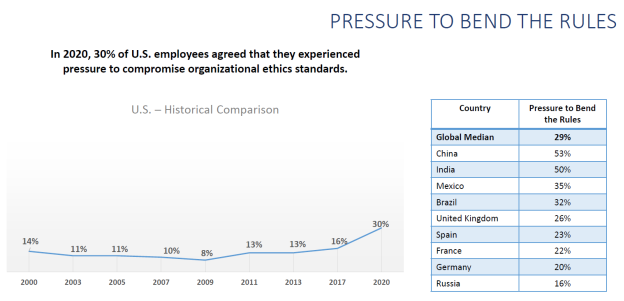Since 1994, the Ethics and Compliance Initiative (ECI) has conducted a longitudinal, cross-sectional study of workplace conduct from the employee’s perspective. In so doing, the ECI has provided compliance and ethics professionals and corporate executives with reliable data relating to trends in key drivers of ethical workplace cultures and how changes in culture impact ethics outcomes.
In March 2021, the ECI released its latest Global Business Ethics Survey Report: The State of Ethics & Compliance in the Workplace – A Look at Global Trends (2021 GBES). The 2021 GBES collected data from employees in 10 countries: United States, Mexico, Brazil, France, Germany, Spain, United Kingdom, China, India, and Russia. Collectively, these data provide business leaders of both US-based corporations and multinationals with key insights into the workplace environments in these jurisdictions that can assist in determining what steps they might take to strengthen their firm’s ethical cultures.
As reported in greater detail below, the 2021 GBES shows that high-quality compliance and ethics programs (HQPs) make a positive difference in promoting strong ethical cultures. But the 2021 GBES data also reveal that much work remains to be done to improve ethics and compliance performance in the majority of companies.
Established in 1922, the ECI comprises the two oldest nonprofits in the ethics and compliance industry: the Ethics Resource Center and the Ethics and Compliance Officers Association. As an association, ECI brings together ethics and compliance professionals and academics from all over the world to share techniques, resources, and exciting new ideas. Visit www.ethics.org for more information about the ECI and its mission.
The power of HQPs
First the good news. In 2018, an ECI working group comprising compliance and ethics professionals from a cross-section of corporations published a white paper entitled: High-Quality Ethics & Compliance Program Measurement Framework (HQP Measurement Framework). The HQP Measurement Framework defines five levels of ethics and compliance (E&C) program maturity:
- Underdeveloped: A new E&C program or an existing one that has not progressed far in embedding HQP elements.
- Adapting: An E&C program that has a few HQP elements, but still lacks many important attributes.
- Defining: An E&C program that contains a number of HQP elements reflecting some important attributes, but with room to further mature.
- Managing: An E&C program that can be considered effective or good, but not an HQP.
- Optimizing: An E&C program that contains the majority of, if not all, HQP elements.
An Optimizing E&C program, as defined by the HQP Measurement Framework comprises one that has the following attributes:
- Strategy: The organization follows best practice in E&C program management and leads the field externally.
- Risk management: Risk assessment follows best practices and includes all aspects of a leading risk management program.
- Culture: Organizational leadership is committed to best practice in E&C program management and leading the field externally.
- Speaking up: A best-practice, formal employee speaking-up/reporting structure is used by employees to report concerns and used by management to identify systemic issues.
- Accountability: The organization is a leader in internal and external communications by demonstrating the value placed on reporting and accountability when wrongdoing occurs; it employs best practices in escalation, tracking, investigation, and root cause analysis and risk mitigation; and it uses well-developed systems of response and upholds a principle of transparency in disclosures where possible.
Importantly, the 2021 GBES found that the higher the E&C program quality on the HQP Measurement Framework scale, the stronger the ethical culture.

This is great news for corporate executives and compliance and ethics professionals alike. It shows that investments made in the quality of E&C programs pay significant dividends.
Some deeply troubling trends
Now for the bad news. Despite the fact that a high percentage of companies with HQPs have strong ethical cultures, the vast majority of firms have not achieved this milestone. The 2021 GBES data reveal that only about one in five US firms have a strong ethical culture and that there has been no significant improvement in this critical metric for more than a decade. The situation is even worse in most of the other countries surveyed.
ECI reports that there is a combined global median of only 14 percent of firms with strong ethical cultures. Surprisingly, France trails other countries with only eight percent of French companies having strong ethical cultures.

But that’s not the worst of it. The GBES also reported that pressure to bend the rules has increased sharply in the United States over the last three years and is at alarmingly high levels in many other countries.

Given the fact that ethical culture strength is the most important driver of employee behavior, it’s not surprising the 2021 GBES found disturbing trends with respect to the pressure statistics detailed above as well as other key E&C program metrics. For example, 62 percent of US managers observed misconduct at work and an alarming 92 percent experienced retaliation for reporting misconduct. Equally troubling is that the global median for retaliation for reporting is 61 percent with India topping the list at an astronomical 90 percent of employees reporting that they experienced retaliation for reporting misconduct. These are not indicators of healthy work environments.
The 2021 GBES observes that the COVID-19 pandemic had a dramatic impact on employees and that this is likely reflected in the survey’s findings. But COVID or no COVID, these data reveal that corporate leaders have their work cut out for them to avoid the inevitable consequences of toxic work environments and poor E&C program performance.
ECI’s recommendations
Taking the 2021 GBES findings into account, the ECI wisely observes that “[t]he time is now to make E&C a priority.” To do so, the ECI recommends businesses, regardless of size and industry, invest in E&C programs using standards such as the HQP Measurement Framework or the US Department of Justice’s Guidance of Effective E&C Programs.
They further recommend firms revisit their organization’s core values and define and promote the standards and behaviors that guide employee actions. Most importantly, the ECI advises corporate leaders to set performance goals for themselves “to visibly support the organization’s values and reinforce the importance of speaking up and listening.”
In my view, companies that make the relatively modest investments required to heed ECI’s advice will enjoy a substantial return on their investment — not just by lowering their enterprise risks — but also by creating a workplace environment that will help them thrive over the long term.




